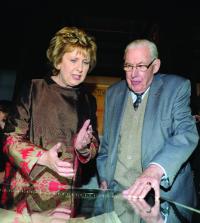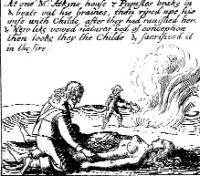Museum eye:Ireland in Turmoil: the 1641 depositions The Long Room, Trinity College Library, Dublin http://www.tcd.ie/history/1641 Until 3 April 2011 by Tony Canavan
Published in 1641 Rebellion, Early Modern History (1500–1700), Issue 6 (Nov/Dec 2010), Plantation of Ireland, Reviews, Volume 18 If you are a first-time visitor to the Old Library in Trinity College, then a ticket for €9 is good value as it includes the Book of Kells exhibition as well as the Long Room, where ‘Ireland in Turmoil’ is located. This marks the transfer to a website of all the 1641 depositions with ‘translations’ into modern English.
If you are a first-time visitor to the Old Library in Trinity College, then a ticket for €9 is good value as it includes the Book of Kells exhibition as well as the Long Room, where ‘Ireland in Turmoil’ is located. This marks the transfer to a website of all the 1641 depositions with ‘translations’ into modern English.

The exhibition includes books published at the time or shortly after, such as these woodcuts depicting alleged rebel atrocities against Protestants from James Cranford’s The teares of Ireland, published in London in 1642. (Trinity College, Dublin)
In keeping with the Long Room, this is a traditional exhibition, with the objects displayed in glass cases and with a minimum of hi-tech gadgetry. There are information panels and one computer where the visitor can access the website, but the maps, manuscripts and books take centre stage. The maps show Ireland in the early seventeenth century and the areas that came under the Plantation. The manuscripts for the most part consist of the depositions made by Protestants who fled the rebels. These recount the terrible deeds carried out against them and commemorated as the massacres of 1641. Reading them, you are struck not just by the intensity of feeling but by the familiarity between perpetrator and victim. The Planters were new to Ireland, but it was their own servants, tenants and neighbours who rose up against them.
The manuscripts and even the books can be difficult (but not impossible) to decipher. Extracts in modern English are provided, with arrows pointing to the relevant part of the original text so that you can have a go at reading it yourself. It brings a tingle to the spine to see the actual seventeenth-century handwriting recording the words of people who survived the rebel onslaught and were eager to recount their stories. Alongside the other books and maps, they bring this period to life and make history something more than just dates and dry text.
The panels in the room attempt to explain the rebellion and to put it in context. One even deals with Trinity itself. The others cover its origins and briefly outline events. ‘Atrocity and Massacre in the Early Modern World’ explains that massacre was an accepted instrument of war, with the enemy, civilians included, being regularly slaughtered in large numbers in Europe and the Americas. What happened in Ireland in the 1640s was not unique, or even outstandingly bloody by the standards of the day.
‘Ireland in Turmoil’ brings us close to events that shaped Irish history. To see the actual documents on which the depositions were recorded and the books based on them is a moving experience. The exhibition is well laid out, and even on a crowded day, as when I visited, it is easy to access the cases and get a close look at what is in them. Ian Paisley may not be there on the day you go but the ghosts of our history will stalk your every step. HI
















